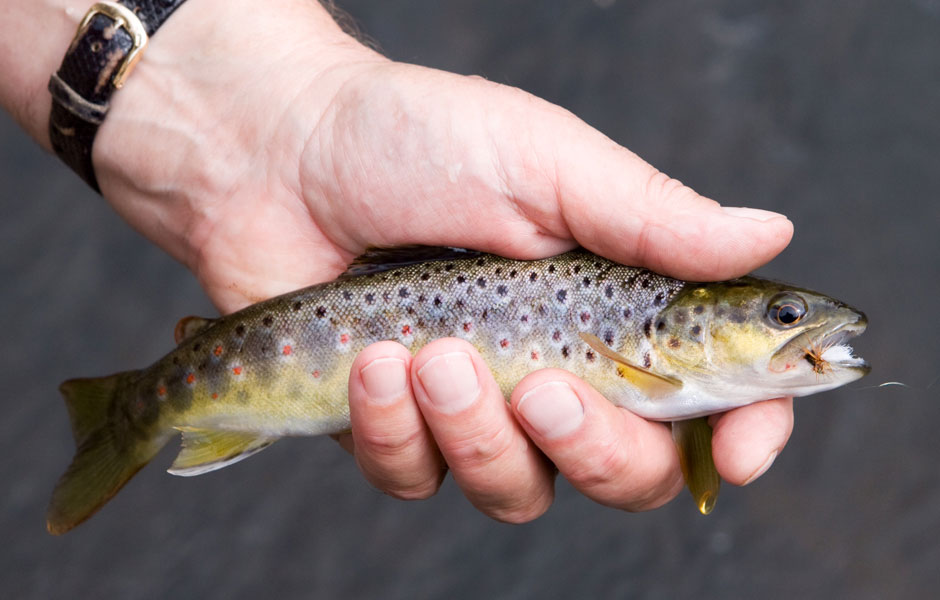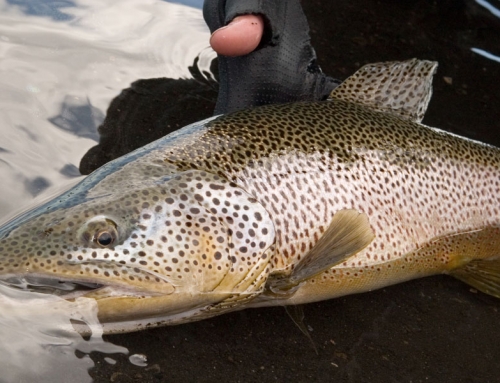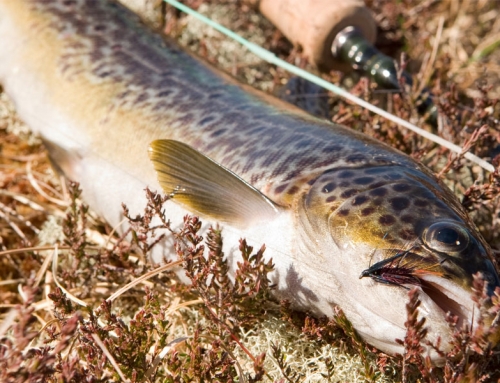Lyn Davies re-discovers a river he fished as a child – the River Lliw, near Swansea.
A very special river cuts its way through the middle of Pontlliw, a village near Swansea where I was born and bred. Every day, on my daily commute home from work I pass over its little road bridge promising myself another visit. Generations of my family have fished the Lliw. Straight from school, I’d run across the fields armed with an 8ft spinning rod and a tin of freshly picked brandlings. Worming was all I knew but it taught me so much about the river and where I’d expect to catch fish. Spate conditions were a favourite as they often proved most productive, especially with the worm. Fishing just inches from the bank, I’d wait for the tell-tale ‘knock, knock, knock’ from a little wild brown trout.
It wasn’t long though before I graduated to fly-fishing. With a size 12 Silver March Brown or Williams Favourite, I’d cast down and across for ever-willing brownies – it was deadly and seemed much more interesting than worming. Unknown to me at the time, this was the turning point in my fishing career. Fly-fishing was suddenly cool, and I was also becoming fascinated with fly-tying. Throughout comprehensive school I continued to fish the river using home-tied wet flies but looking back, I never experimented with the upstream dry fly or nymph.
Over 20 years later, I arrange a return visit with good friend of mine, Wye Valley angling guide, Oliver Burch. Like me, Oliver has a passion for chasing pint-sized brown trout in small streams. It’s a cloudy day in mid-August and the river is running clear but carrying a healthy amount of water following the recent rains. To save walking back on ourselves, we head off in two cars, leaving one near to the village of Felindre (our destination) and drive to the town of Gorseinon, some 3-miles further downstream to begin fishing. We tackle up from the back of the car overlooking some waste ground, just a 5-minute walk from the river. Instead of using a hand-me-down rod, I’m now holding a top of the range 7ft, 3wt, Hardy Marksman and its accompanying fly reel. How times have changed! It’s always nice to put together such a small wand – a refreshing change from the usual 10ft, 8wt sea trout rod I have become so familiar with during this time of year.
The set-up is simple. You rarely cast further than 10yds, roll-casting more often than overhead due to the overgrown environment. My Marksman reel is loaded with a Snowbee XS, WF3 whereas Oliver is fishing with a Cortland 444, DT3. Personally, I prefer a weight-forward as it’s easier to shoot line out in restricted areas. There’s certainly a more relaxed feel about a double-taper line and they are noted for their presentation. A 6ft home-tied tapered leader connects to my braided loop and I’ve attached a 2mm tippet ring to the end, via a tucked blood knot. When fishing overgrown streams, you inevitably get caught in tree branches and loose flies, so tippet rings preserve the main tapered section and make it easy to change the 2–3 tippet. A single, size 16 Klinkhammer completes the set-up – I prefer olive colour ‘Klink’s’ but Oliver has more confidence in the tan variations. We run some leader sink over our tippet sections and apply a small amount of Gink to the bodies of our flies. Waders on and nets attached, we’re ready to fish. With so much walking involved I prefer to wear a chest pack but only containing the essentials – a couple of fly boxes, spare nylon, a chocolate bar, and a bottle of water.
Within minutes we reach the river. Oliver seems impressed looking upstream towards some inviting runs. We leapfrog each other, taking it turns to cast and it’s not long before a lively little brownie is splashing on the surface. Oliver has hooked into his first Lliw fish. It’s all of 6-inches but with its butter-coloured underside and large red spots, it’s pretty as a picture laying in his pan-net. It’s the start of things to come. Our Klinks are causing a stir in most places although some open areas seem less productive. They areas are easier to fish but the lack of cover probably puts off the trout as they become more vulnerable to predators. We notice a couple of man-made weirs; someone someday has also tried to encourage groins and pools along its course. Soon the sun is peeping through the clouds, and we see the first sign of fly-life. Small black sedges are fluttering around us, and the odd olive is seen on the wing. Approaching a long open bank, I spot a splashy rise which would suggest a trout has taken a natural up-winged fly. The fish had taken an olive which was floating temptingly downstream. It’s Oliver’s turn to fish, so I keep my distance with the camera in hand. Following a few well-positioned casts, the trout turns on his fly and it’s a better one, making his 3wt-rod work hard as it makes a bid for freedom. Soon a lovely 8-inch brownie is subject to a photoshoot before being is released. Well done, Oliver.
Turning a corner, I recognise a landmark in the distance – it’s the M4 motorway bridge which passes over the Lliw between junctions 47 and 48. With the drone of traffic we weave in and out of some overgrown sections and clamber over a couple barbed-wire fences before reaching some open fields that skirt the village of Pontlliw. We soon reach the perimeter of Lliw Mill trout farm and are welcomed by two barking dogs. Proprietor and fishing pal Reggie Street runs the rainbow trout farm which is perfectly situated to receive water from the Lliw via a feeder stream controlled by an ancient sluice gate. Unknown to most, the Lliw also experiences a small run of salmon and sea trout towards the back end of the season. Reggie often discovers small sewin amongst his stew ponds and tells stories of large salmon holding in the pools during autumn.
Hearing the dogs, Reggie soon appears through the trees to investigate. Himself an avid fly-fisherman, he’s keen to know how we’d fared lower downstream. The conversation soon moves towards a well-known story of a fish-farmers nightmare, some 20-years previous. Following an unusually large spate, literally hundreds of half-pound rainbows escaped from the farm, filling the pools of the river immediately downstream. Locals have never forgotten the event – including myself. For days, hordes of locals lined the banks taking huge bags of escapees using bread and maggots! Fortunately, since taking over the farm, Reggie has secured the fishponds and now only loses the odd fish. As any fish-farmer will tell you though, he fights a constant battle with natural predators, such as otters, mink, and herons.
We’re overlooking a part of the river I know very well and much remains unchanged. A have vivid memories of catching what seemed like huge fish at the time, along with other childhood experiences including kissing innocent schoolgirls and generally getting up to mischief! We move on towards a picturesque and well know weir pool. Above is ‘Pen-fach’ pool, one of the widest and deepest pools in the area. Legend has it, a farmer’s daughter drowned here, and it always proved a popular spot for local children to hang out – the remains of old rope swing can still be seen. I catch one small fish in Pen-fach before we move on. The river seems to be closing in on us, at times it’s so overgrown that we struggle to even walk along the riverbed. Overhanging trees and bushes test our patience, and we find ourselves skipping areas because it’s virtually impossible to fish – a few hours work with a handsaw could expose so much more fishing. Approaching pool tails, we see fish darting off for cover amongst the underwater tree roots. It’s challenging fishing and soon we only seem to be taking fish from the deeper holes.
Heading towards the village of Felindre, I’m in unknown territory. As a child, I never ventured this far upstream – it seemed miles away at the time. We continue to take the odd small fish, apart from one good one which measured 11-inches. It had a particularly large head, somewhat disproportionate to the rest of its body suggesting a lack of available food for larger fish. Soon the river opens out and I spot a recently renovated bungalow that confirms my position. It’s surprisingly easy to lose your bearings amongst an overgrown deep valley. The river is now running wider through a lush newly landscaped area, at last we can cast without battling with the trees – it’s a luxury.
We’ve just a couple more pools to cover before making an exit up a steep farm lane towards our car. Presented with a picture book run ahead, I cast into the shallows and to my surprise a fish immediately splashes over my fly. It’s clearly a good one, and rips line off my little Marksman reel in a bid for freedom. Soon a very handsome 12” brownie comes to hand and Oliver has also taken a fish of a similar size just downstream – two fantastic trout for the Lliw and a fitting end to a great day. We finish with over 20 fish between us, having probably lost just as many. The dry fly had worked a treat and Oliver is VERY impressed with what ‘my’ little river has to offer. The Lliw had won over an experienced, visiting angler and there’s already talk of another visit. Don’t expect to catch monsters, the average fish is between 6–8 inches but there’s always the chance of something larger, or even a rainbow! The lower stretches seem to fish better and more accessible. Be prepared to battle with a few barbed-wire fences and the noise from the busy M4 motorway can be off putting. Finally, I almost forgot to mention one important point – the fishing is free! It’s always been this way; it seems all you need is the permission from the landowner to wonder the fields.




Leave A Comment